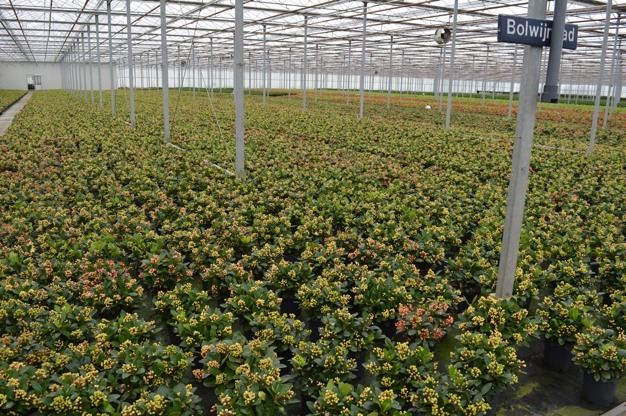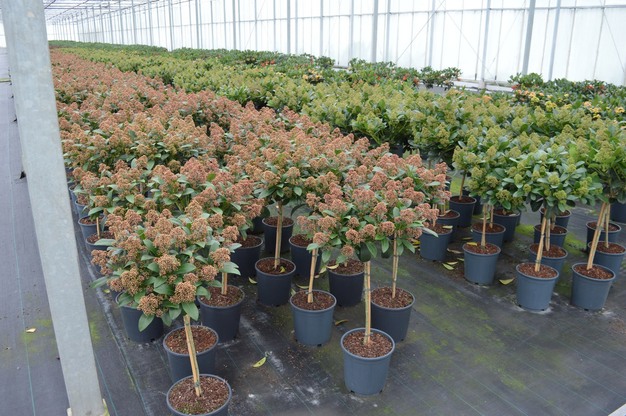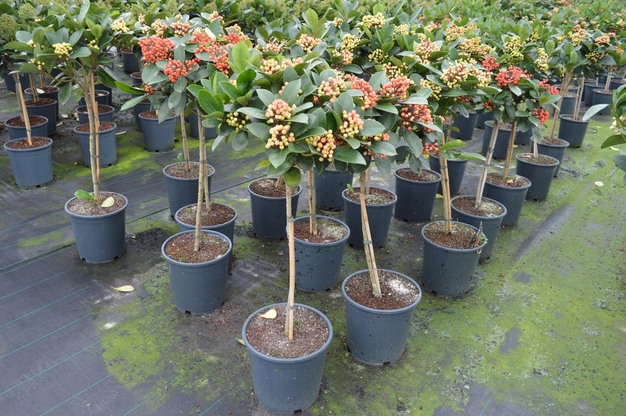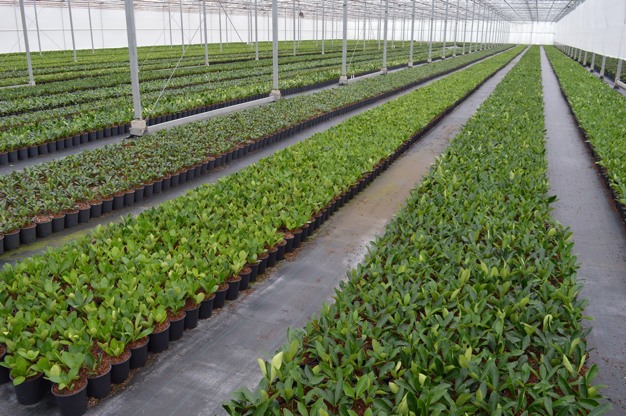Now that the season is starting up again and the greenhouse is gradually turning bright red, it’s all hands on deck at Skimmia Nursery Bolwijn in the Netherlands. A good moment to take a look behind the scenes at this exclusive product, of which Chris and his wife Mariëlle Bolwijn only market their own, unique varieties.

Jan Marijnis and Chris Bolwijn
Back in the late 1950s, Chris’ father started a plant nursery in Putten, the Netherlands. First, it was all done in open ground, but later, he started using pots with a size of 7 cm. In 1982, they moved to a larger 6-hectare nursery, and around 2010, the company moved to its current location in the Netherlands, IJsselmuiden.

A sea of berries, which are now rapidly turning red
When Chris joined the company in the early 1990s, he was given the skimmia as a gift from his father, so to speak. Crossing and breeding became one of his interests, and after horticultural school in Boskoop, he was able to work with it full-time. “In those days, we still had a large assortment, a high turnover, and little income. That had to change, I thought, and I saw opportunities – even then – to fully become skimmia specialists.”

Several sorts with florets
And he did. Thirty-three years have passed since the first crosses, and Skimmia Kwekerij Bolwijn has become known thanks to some exclusive varieties from its own breeding. In recent years, skimmias on the stem have also been added to the range. This is something that no one had ever marketed before on a commercial scale and which has only been possible thanks to a self-developed rootstock on which the plants can be grafted. Currently, the grower has four varieties available; the plants on the stem are marketed under the name Golden Series.

The Miracle and Illusion on stem
There isn’t an overly large market for skimmias, but there are certainly other growers. However, the majority of them have focused on the “standard” skimmia, the so-called Japonica Rubella, the mother of all skimmias. Only a few have done any crossing and breeding with it, and as far as we know, there is no one on the market with a comparably large assortment of their own varieties. Bolwijn has about 25 of them, 4 of which can be grafted on a stem. Two of these have florets, and the other two are berry-bearing.

The Obsession on stem
Plant with a manual
It is clear that this situation won’t change overnight. The plants’ cultivation takes a long time, it requires horticultural expertise, and growing a uniform batch of plants is still quite a challenge. Nor is it the easiest; it is reportedly a sensitive plant and requires almost year-round attention and maintenance. Chris stakes the plants in the summer; a year later, he has young plants. The following year, these grow flowers, and the year after that, they get berries. So it always takes at least two, often three, and for the even larger plants, four years. Moreover, in order to get berries, they have to be pollinated, a crucial step in the process that requires highly specialized expertise.

Young plants planted this year
You can only sell each plant once
In terms of labor, the grower does everything themselves; only during potting are some extra hands needed. Also, Jan Marijnis was brought in from Royal FloraHolland Sales Management four years ago to be in charge of sales. Paradoxically, that marketing isn’t really necessary; the product is so exclusive that “it will sell itself.”; the trick is to make sure you always have something in reserve so you are never completely sold out. Also, regardless of how agreeable and good paying they are, you don’t want to have just a handful of customers taking all the plants. Ideally, every garden center and exclusive florist across Europe should have a few on the shelves and come back for more every year.

Season in full swing
The marketing season is starting now and will continue until around Christmas. During that time, normally, about a third of the crops are taken from the greenhouse. The rest is kept until the next year in order to get flowers or more berries or to be grafted onto a stem. They hope to be able to expand the range in the near future.
For more information:
Skimmia Kwekerij Bolwijn
Chris Bolwijn – [email protected]
Jan Marijnis – [email protected]
https://bolwijn.com/
https://goldseries.eu